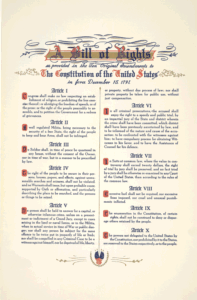The First 10
Ratification of the Constitution was contingent upon subsequent ratification of amendments limiting the power of the federal government and protecting the people’s rights/freedoms. The “Bill of Rights,” drafted/introduced by James Madison and influenced by the Magna Carta (1215), English Bill of Rights (1689), and Virginia Declaration of Rights (1776), became the first ten amendments to the Constitution, ratified in 1791.
Incorporation
The Bill of Rights included protections by and from Congress and not the states. Yet, over time, the Supreme Court would selectively incorporate freedoms and protections within the Bill of Rights through the Due Process Clause of the 14th amendment to apply to the states.
- The Bill of Rights includes protections against government infringing on free speech, press, assembly, exercise of religion, the right to bear arms and petition for redress of grievances, to a speedy and public trial, to a jury trial, and to confront witnesses. Rights not mentioned are retained by the people and powers not delegated or prohibited are reserved to the states or to the people.
- Amendments include protections against cruel and unusual punishment, double jeopardy, self-incrimination, establishment of religion, unreasonable searches and seizures, soldiers quartering in homes, deprivation of life, liberty or property without due process, and the taking of private property for public use without just compensation.
Barron v. Baltimore (1833)
The Supreme Court held that the Bill of Rights only applied to the federal government and did not place restrictions on the states. Learn More
Palko v. Connecticut (1937)
The Supreme Court held that some freedoms in the Bill of Rights were fundamental, such that they could be incorporated through the Due Process Clause in the 14th Amendment and applied to the states. Learn More
- Constitution Annotated, produced by the Congressional Research Service
- Bill of Rights Institute, providing educator resources on the Bill of Rights
- Carol Berkin, The Bill of Rights: The Fight to Secure America’s Liberties (2015)
“Bill of Rights Overview,” in Education, posted by the National Constitution Center, featuring multimedia and activities to use in the classroom.
“A Day for the Constitution,” posted by NEH-EDSITEment.
The Story of the Bill of Rights from the Annenberg Classroom. This video describes the process leading to the addition of the Bill of Rights to the Constitution and why the freedoms and protections included in these first ten amendments are essential to American democracy. There are also short videos focusing on each amendment, and there is a handout for teachers, including a lesson plan, to use with the video.


